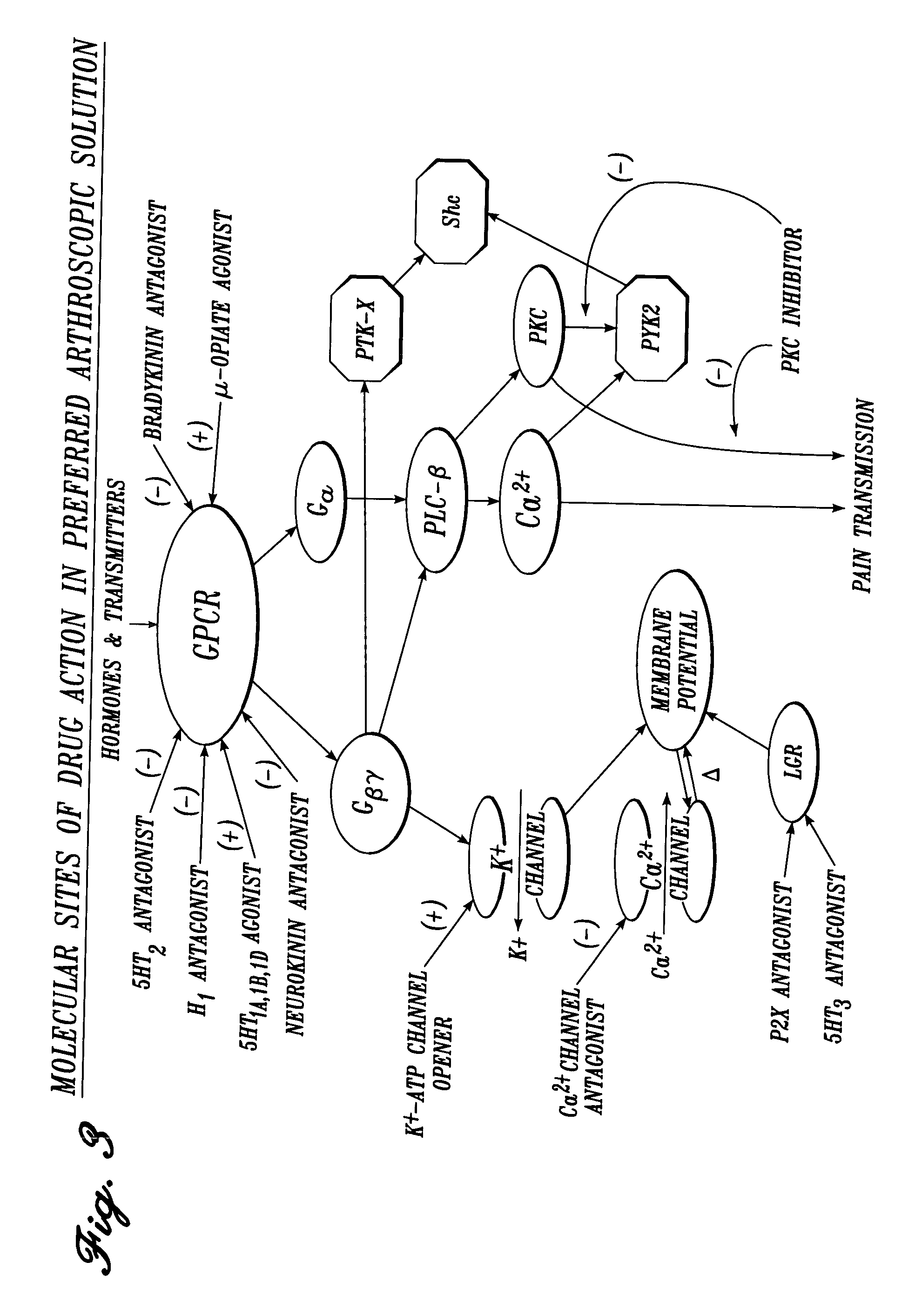Vascular irrigation solution and method for inhibition of pain, inflammation, spasm and restenosis
- Summary
- Abstract
- Description
- Claims
- Application Information
AI Technical Summary
Benefits of technology
Problems solved by technology
Method used
Image
Examples
example i
A. Example I
Irrigation Solution for Arthroscopy
[0162] The following composition is suitable for use in anatomic joint irrigation during arthroscopic procedures. Each drug is solubilized in a carrier fluid containing physiologic electrolytes, such as normal saline or lactated Ringer's solution, as are the remaining solutions described in subsequent examples.
25TABLE 25 Concentration Class of (Nanomolar): Most Agent Drug Therapeutic Preferred Preferred serotonin.sub.2 antagonist amitriptyline 0.1-1,000 50-500 100 serotonin.sub.3 antagonist metoclopramide 10-10,000 200-2,000 1,000 histamine.sub.1 antagonist amitriptyline 0.1-1,000 50-500 200 serotonin.sub.1A,1B,1D,1F agonist sumatriptan 1-1,000 10-200 50 bradykinin.sub.1 antagonist [des-Arg.sup.10] 1-1,000 50-500 200 derivative of HOE 140 bradykinin.sub.2 antagonist HOE 140 1-1,000 50-500 200
example ii
B. Example II
Irrigation Solution for Cardiovascular and General Vascular Therapeutic and Diagnostic Procedures
[0163] The following drugs and concentration ranges in solution in a physiologic carrier fluid are suitable for use in irrigating operative sites during cardiovascular and general vascular procedures.
26TABLE 26 Concentration (Nanomolar): Class of Agent Drug Therapeutic Preferred Most Preferred serotonin.sub.2 antagonist trazodone 0.1-2,000 50-500 200 serotonin.sub.3 antagonist metoclopramide 10-10,000 200-2,000 1,000 serotonin.sub.1B antagonist yohimbine 0.1-1,000 50-500 200 bradykinin.sub.1 antagonist [des-Arg.sup.10]1-1,000 50-500 200 derivative of HOE 140 cyclooxygenase inhibitor ketorolac 100-10,000 500-5,000 3,000
example iii
C. Example III
Irrigation Solution for Urologic Procedures
[0164] The following drugs and concentration ranges in solution in a physiologic carrier fluid are suitable for use in irrigating operative sites during urologic procedures.
27TABLE 27 Concentration (Nanomolar): Most Class of Agent Drug Therapeutic Preferred Preferred histamine.sub.1 antagonist terfenadine 0.1-1,000 50-500 200 serotonin.sub.3 antagonist metoclopramide 10-10,000 200-2,000 1,000 bradykinin.sub.1 antagonist [des-Arg.sup.10] 1-1,000 50-500 200 derivative of HOE 140 bradykinin.sub.2 antagonist HOE 1401-1,000 50-500 200 cyclooxygenase inhibitor 100-10,000 500-5,000 3,000
PUM
| Property | Measurement | Unit |
|---|---|---|
| Molar density | aaaaa | aaaaa |
| Molar density | aaaaa | aaaaa |
| Molar density | aaaaa | aaaaa |
Abstract
Description
Claims
Application Information
 Login to View More
Login to View More - R&D
- Intellectual Property
- Life Sciences
- Materials
- Tech Scout
- Unparalleled Data Quality
- Higher Quality Content
- 60% Fewer Hallucinations
Browse by: Latest US Patents, China's latest patents, Technical Efficacy Thesaurus, Application Domain, Technology Topic, Popular Technical Reports.
© 2025 PatSnap. All rights reserved.Legal|Privacy policy|Modern Slavery Act Transparency Statement|Sitemap|About US| Contact US: help@patsnap.com



